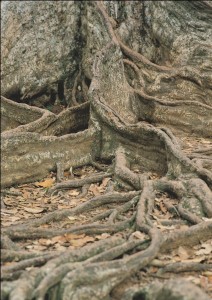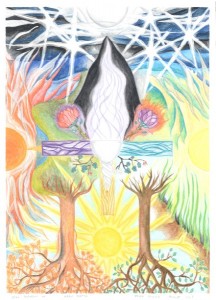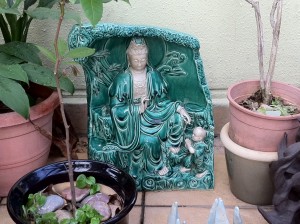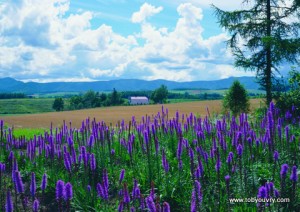This week’s article looks at the need to develop a healthy mind-body connection and how to increase the amount of subtle energy, or ‘qi’ within our body. There is an opportunity for those of you in Singapore to participate in a Qi gong walking meditation class this coming Sunday morning, 4th December; I have placed the full details of this beneath the article.
Finally, I gave a short talk at the end of a Qi gong meditation class last week on why it is that we sabotage our meditation practice due to an unconscious fear of inner space and stillness. You can read a transcript of this talk here in an article I have entitled “Our Anxiety in the Face of Inner Space and Stillness” .
Yours in the spirit of inner and outer energy,
Toby
 Article of the Week:
Article of the Week:
On Regenerating Your Energy Body and Walking Mediation
Recently I was at a healing event with my wife. One way or another we both had the opportunity to place our hands on various members of the public for healing purposes. One of the things that we both remarked upon in our conversation afterwards was how little qi, or subtle energy seemed to be circulating in the bodies of some the people we had been working with. It almost seemed like although there was clearly a mind in the body somewhere, there was no energetic link between the person’s mind and body to give life force, sustenance and nurturing to the physical being. It was like there was a biological body, then a gap, and then their mind. So, with this in mind I thought I would pass on a couple of meditations that can help improve our mind-body connection, and increase the amount of subtle energy, qi or life force in our energy body
A good mind-body connection is one of the most beneficial and important gifts that we can give ourselves. If we try and meditate without it we will find that our meditation will become rather flat and abstract. Conversely, if our body has a healthy flow of subtle energy and life force within it then any meditation or consciousness work that we do will tend to feel fuller, deeper and more rounded.
With this in mind I thought I would share with you one of the main meditations that I use to help encourage the circulation of qi and life-force within my body, which is a simple energy body meditation, based around the principles of qi gong. It is really easy to learn, and once you are used to it you can do it not only in formal meditation, but also by keeping your awareness of it in your daily life, such as when sitting at your desk or travel ling. Click here to read the instructions for doing the energy body meditation that I have posted on my Qi gong blog
Another great way to improve your mind-body connection is by doing walking meditation. Walking meditation necessarily increases your mind-body connection because you are combining mindful awareness with the movement of your body as you walk. Another advantage of walking meditation is that you can integrate it into your daily routine as you move around from one place to another. You can read the basic introduction to walking meditation that I have recently edited and re-posted on my meditation website.
© Toby Ouvry 2011, you are welcome to use or share this article, but please cite Toby as the source and include reference to his website www.tobyouvry.com
Sunday Morning Qi Gong Walking Meditation Classes at the Botanic Gardens
Time and Date of next class: 8-9am Sunday 4thth December
Relax, rejuvenate and regenerate yourself on Sunday morning at the Botanic Gardens.
We will be practicing simple Qi Gong and walking meditation techniques to cultivate our inner peace, balance and sense of connectedness to the Earth and nature. Once learned these are techniques that you will also be able to use at other times in your daily life.
The class will be suitable for regular walking mediators/Qi gong practitioners and first timers.
Meeting Point: 8am by the Bukit Timah Gate of the Botanic Gardens, next to the entrance of the Botanic Gardens MRT station. For a map please click HERE
To register or for further enquiries: Email info@tobyouvry.com or SMS 96750279
Class Fee: $25
About the Teacher: Toby Ouvry is a meditation teacher and artist who has been practicing Qi gong for over fifteen years and teaching it for seven years. You can find more out about Toby and his work by going to www.tobyouvry.com , or check out his Qi gong blog by going towww.tobyouvry.com/qigong
Background information on Qi Gong:
One of the most ancient and effective forms of preventative heath care in the world today, qi-gong represents a series of invaluable breathing and movement exercises which can help our body and mind keep at peak energy levels in the face of today’s demanding and stressful modern lifestyle and schedules.
Qi-gong is the science of working with the body’s energy field. Literally translated into English it means ‘energy work’, or ‘energy skill’. In these classes we will be learning the art of moving energy into and around our body using a series of simple and easy to apply techniques that will enable you to:
- Re-establish your body’s natural bio-rhythms
- Harmonize your nervous and endocrine systems
- Invigorate your body tissue and organs with oxygen rich blood and vital energy
- Clear stagnant energy from your system and help build your energy fields to their optimum health levels!
General information on Walking meditation:
Increasingly many people are becoming aware of a need to find a sense of inner calm, peace and centeredness in order to cope effectively with the stresses and strains of modern life. However, it seems equally difficult to find the quality time for a practice such as meditation that can actually help us to accomplish this.
A solution to this can be found in walking meditation. All of us do a certain amount of walking in our life. By learning walking meditation we can combine the time that we spend walking with time spent cultivating our inner peace, stability and happiness. It is a win win situation!!








